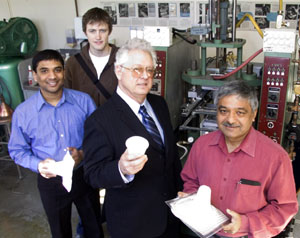« Washington Engineer - May 2006
ME students may have java’s next big thing

- Some of Microgreen’s main players show cool cups in front of the machine that will produce the start-up’s initial products. From the left, ME doctoral candidate Krishna Nadella, graduate student Stephen Probert, ME alum and Microgreen President and CEO Greg Branch, and Professor Vipin Kumar, who shepherded the group through the start-up process.
If nothing else, Krishna Nadella is persistent.
Just ask Greg Branch.
The two worked in the same lab as graduate students in the University of Washington’s Department of Mechanical Engineering, and when Nadella got an idea that he thought was a winner, he wouldn’t give up.
“He kept calling me,” recalled Branch, now president and CEO of the start-up company the two co-founded. “He really wouldn’t take no for an answer. And here I am.”
Two years and more than $2 million in funding later, Branch and Nadella are preparing to launch MicroGreen Polymers Inc. into the rough-and-tumble business world with a product that is less ordinary than it seems: a coffee cup.
What makes this cup different? It’s eco-friendly and highly heat resistant, according to Nadella.
“It’s a green technology – it’s made from recycled materials, and can be recycled,” he said. “It insulates even better than double paper cups.”
“And we can make it at a cheaper cost than paper,“ Branch added.
The secret is a thermoformed plastic techique developed at the UW – Branch did his master’s thesis on the process, which Microgreen has licensed from the university – that puts millions of tiny bubbles into the type of plastic used to make soda pop bottles. As many as 100 of the bubbles could straddle a human hair.
The result is a plastic that is nearly 80 percent air.
That packs a double-punch in terms of making the polymer practical for coffee cups: It uses a relatively small amount of material and the bubbles provide a high level of insulation. As a result, the relatively thin plastic cups easily ward off the singed fingers so familiar to hot joe aficionados.
Originally, Branch and Nadella thought of marketing the product as a new type of carpet padding. But the two quickly realized that food packaging was a more lucrative path to take.
They submitted their idea in a business plan competition sponsored by the UW in 2003, and came away winners. Similar success in other competitions netted a total of about $40,000, which provided seed money for the enterprise.
They set out to develop the idea, figuring out how to form the sheets of plastic into cups, trays and other useful shapes. In their first round of fundraising, completed in February, MicroGreen raised $2.4 million. They have a machine operating in the Engineering Annex at the UW to put out formal product prototypes. And the company has rented office space near the Arlington, Wash., airport to set up a manufacturing plant.
“We need to show that our idea is scalable,” Nadella said. “We need to show that we can produce it at industrial manufacturing speeds.”
People are taking notice. MicroGreen already has a joint development agreement with Reynolds Food Packaging, part of Alcoa. The company has also signed a deal with a Japanese electronics manufacturer, which will use the material in LCD televisions.
“When people think of start-up companies, they usually think of biotech or computer science,” Nadella said. “I think this shows that there is still a lot of opportunity in manufacturing.”
The venture has been a learning experience for all involved, according to Vipin Kumar, a UW mechanical engineering professor who runs the microcellular plastics lab where Nadella and Branch met and has actively mentored the students.
“This is an important aspect of engineering that students don’t often see until they get out into the real world,” Kumar said. “I have to hand it to the UW for working with us and giving the students the space to run with their idea. It rounds out their education.”